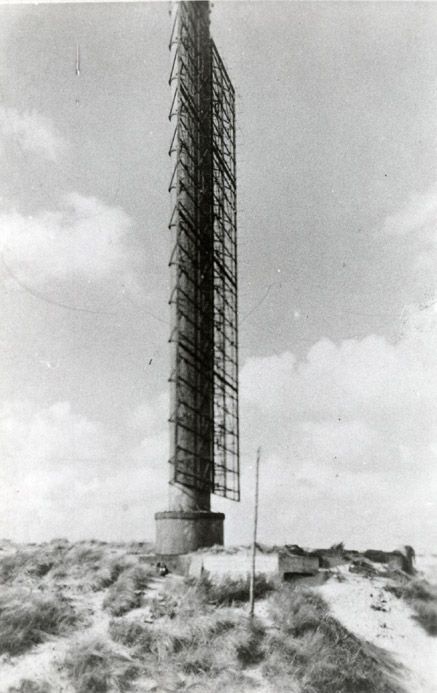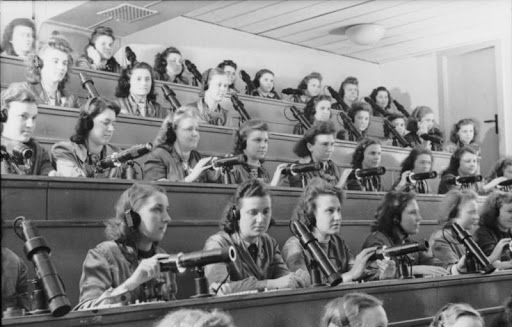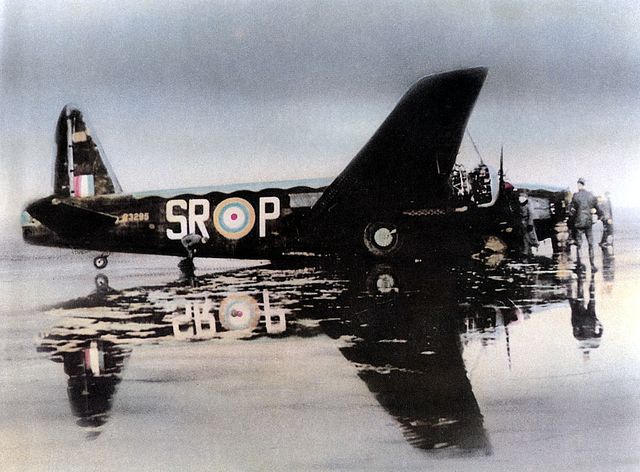In February 1942, construction of the Neue Westwall began. Along the coast, the army built bunkers for coastal and anti-aircraft artillery, fire-control systems and observation towers, bunkers for close defence and side control artillery, ammunition bunkers and crew living quarters as well as communication bunkers, radar bunkers and command bunkers.
The Luftwaffe placed tracking devices, huge swivelling installations on circular cement rings, to lead the aircraft to their target in England. They were given names like Knickebein and Bernhard. These installations sent out a signal. Using a cross-bearing from two different devices, the target in England was marked for the German aircraft. When they reached this target, they heard a signal and dropped their bombs. These installations were mainly active during the first part of the war when Germany still believed in an offensive against England and a war on two fronts was still unheard of. After the occupation of the Netherlands, a Knickebein was installed near Den Helder, and later a Bernhard near Schoorl.
The Luftwaffe and the Kriegsmarine already had advanced radar installations early on in the war. The navy had its own type of Mammut bunker (V143) to detect surface ships. The Freya radar was the first that could ‘see’ aircraft from a distance. From 1942, radar installations were placed along the coast that could detect aircraft from long distances: from 300 kilometres with the Mammut radar and 200 kilometres with the Wassermann radar. These radar installations formed the first line and were placed only in the coastal area at 65 kilometre intervals in order to trace the incoming allied formations in advance. The Würzburg radar was used to detect enemy aircraft at shorter distances (40 km). This radar could determine the flight altitude of the enemy aircraft. With the arrival of the Würzburg Riese, this distance was increased to 85 km. It was only for the Mammut and the Wassermann that large bunkers were specially designed as a foundation and immediate shelter for the equipment, all the others were standard designs.

The Luftwaffe had two long-distance radars: the Mammut and the Wassermann. They had various specific bunkers as a foundation. The smaller Freya and Würzburg installations stood on rather small foundations. The crew and equipment for these installations were housed in thin-walled bunkers in the immediate vicinity.
View of West-Terschelling, with the Wassermann radar antennae on the Seinpaalduin, which could see the English squadrons just after taking off.

Behind the first line of radar stations along the coast, there was a network of radar installations spread out across the whole of Western Europe. The installations were placed approximately 40 kilometres apart. At each location, a Würzburg radar was combined with a searchlight. The radar located the incoming aircraft which were then captured in the searchlight.
Würzburg D fire control radar near the Flak battery, Hollum.
(Ameland, 6 August 1942)

All signals were sent to the so-called Unterstände für Funkmessgeräte-Auswertung Jafü (Jagdfliegerführer). There were two standard types: L479 (Anton) and L487 (Bertha). All of the movements, both enemy and own aircraft, traced by the radar installations in a large area, were collected in these bunkers. They were then projected on a glass screen with their coordinates and images of the coastline, a so-called Seeburgtisch.
The screen projections were done by the so-called Blitzmädel (officially Wehrmachthelferinnen), women in the German air force who worked at these command centres. It was from here that the German hunters were led to their targets, the allied aircraft. Data were also sent to the central command centres in Stade near Hamburg, Deelen (Diogenes) and Metz, who were in direct contact with Luftwaffe headquarters in Berlin. This made it possible to carry out large-scale operations to warn air defence centres and mobilise anti-aircraft artillery. In the Netherlands, three of the Bertha types were built: on Terschelling as part of the Tiger Stellung, near Zandvoort and near Brielle. A fourth was planned near Den Helder but was never built.
Blitzmädel or Wehrmachthelferinnen on bleachers at an air command bunker.


